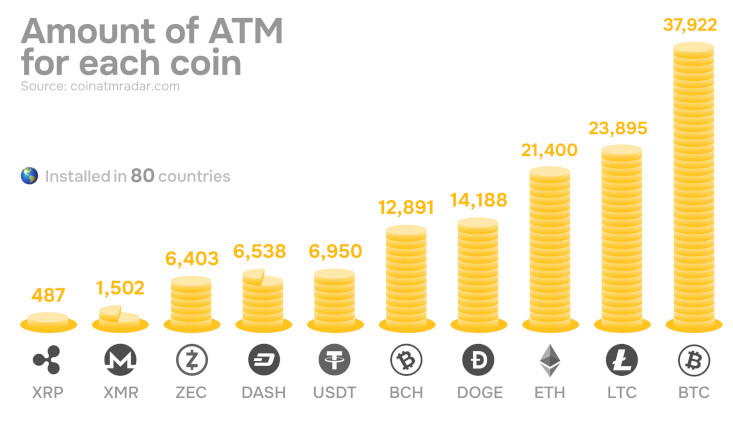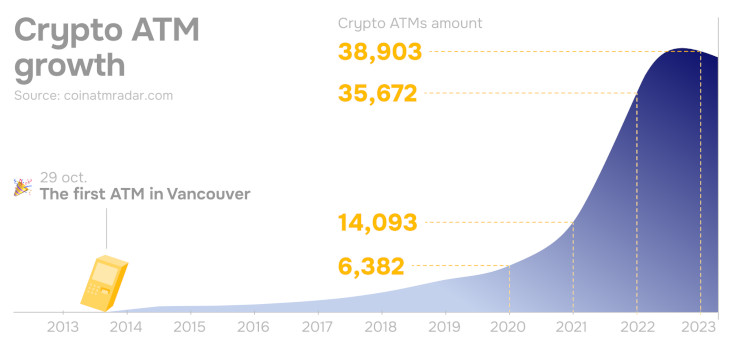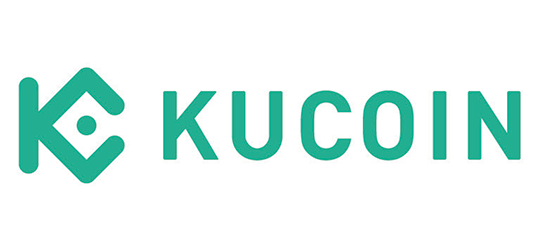
Where to Buy Bitcoin Offline and How to Find Bitcoin ATMs Worldwide
Bitcoin ATMs are used for purchasing Bitcoin or other cryptocurrency. ATM machines provide an easy way to purchase and sell Bitcoin instantly without complicated exchanges or online wallets. In this article, we'll explore what Bitcoin ATMs are, how they work, and how to cash in crypto at them.
Understanding Bitcoin ATMs
Bitcoin ATMs, also known as crypto ATMs or BTMs, are stand-alone electronic kiosks that enable users to buy and sell Bitcoin using cash, debit cards, or a cryptocurrency wallet. These ATMs are not connected to traditional banking systems but instead link directly to cryptocurrency exchanges through the Internet.
Although they are called Bitcoin ATMs, most of these machines support transactions involving other altcoins such as Ether (ETH), Bitcoin Cash (BCH), Dash (DASH), and Litecoin (LTC) among others. Here is a chart showing the ratio of cryptocurrencies to Bitcoin ATMs that support them:

The birth of cryptocurrency ATMs can be traced back to October 29, 2013, when the first-ever Bitcoin ATM was introduced at Vancouver's Waves Coffee Shop in Canada. Shortly after, Bratislava, Slovakia saw the installation of the first Bitcoin ATM in Europe on December 8, 2013. The United States joined the Bitcoin ATM trend on February 18, 2014, with the installation of an ATM in Albuquerque, New Mexico.
Similar to the cryptocurrency itself, Bitcoin ATMs encountered regulatory challenges. Eventually, it was agreed that Bitcoin machines must adhere to the same laws and regulations as traditional ATMs. This meant implementing limits on deposits and withdrawals per transaction and per day.
Disclaimer. Be sure to check the laws in your country before using and paying with cryptocurrencies, as it is illegal in some countries.
As of May 2023, there are over 34,000 Bitcoin ATMs globally, with the majority located in North America, Europe, and Asia.

How Does Bitcoin ATM Work?
Bitcoin ATMs can be categorized into two main types: one-way and two-way machines. One-way ATMs allow users to buy Bitcoin only, while two-way machines offer the additional option to sell Bitcoin instantly.
Bitcoin ATMs are not connected to bank accounts. Instead, these machines simply facilitate blockchain-based transactions. In other words, they directly connect with cryptocurrency exchanges to provide instant buying and selling capabilities. These exchanges also determine the exchange rate based on the current market value at the time of the transaction.
Bitcoin ATMs typically consist of a touchscreen interface, a QR scanner, a bill acceptor, and a dispenser. The Bitcoin machines need an internet connection to power the exchange of cryptocurrency for cash. They typically use a public key on the blockchain or sometimes provide paper receipts for the transaction.
Unlike traditional ATMs that handle physical deposits and withdrawals, Bitcoin transactions are entirely blockchain-based. To send cryptocurrencies to a user's Bitcoin or other cryptocurrency wallet, the ATM generates a unique QR code that corresponds to the crypto wallet address. Users are prompted to scan this QR code, and once the transaction is completed, the purchased coins are transferred to their wallets. After a few minutes of processing, a record of the transaction appears in the user's digital wallet.
Depending on the transaction amount, the ATM may request your cell phone number to send a verification code via text. Additionally, some transactions may require you to scan a government-issued identity, such as a driver's license, as part of the verification process.
Crypto ATM Fees and Limits
Crypto ATMs often charge high transaction fees that can significantly impact the cost of using these machines. These fees include various charges such as crypto exchange fees, cash exchange fees, and card processing fees when using a debit card. The extent of these fees can reach as high as 20% or even more, depending on the specific ATM and the type of transaction. Fees of crypto ATMs vary across different machines. Some ATMs may impose lower fees ranging from 2% to 4%, however, the majority tend to charge significantly higher fees.
Bitcoin ATMs also impose specific limits on transactions, both in terms of minimum and maximum amounts. Typically, these ATMs have a minimum transaction limit of around $20, while the maximum limit per day can vary depending on the ATM provider, ranging from $3,000 to $9,000.
While some Bitcoin ATMs may offer the option to buy or sell cryptocurrencies instantly without charging any service fees, finding such machines can be pretty challenging. It's important to note that even if an ATM claims to have zero service fees, the price of cryptocurrencies available on these machines tends to be higher than the prevailing exchange rates.
How to Find a Bitcoin ATM?
Bitcoin ATMs locations may be in cafes, specialty shops, and transport hubs like rail stations and airports. While the majority of Bitcoin ATMs are concentrated in North America, they can be found in various locations worldwide. Here is a map showing the distribution of ATM machines around the world:

Where is the nearest Bitcoin ATM? To find a Bitcoin ATM near you you can use tracking websites that will allow you to search for an ATM by location Coin ATM Radar is currently the most popular website, its database lists more than 34,000 crypto ATMs worldwide. By following these steps, you can easily locate the nearest Bitcoin ATM using the Coin ATM Radar
- Visit Coin ATM Radar. You'll be greeted by a Bitcoin ATM map that displays locations all over the world.
- In the upper left-hand portion of the map, you'll find a search box. Type in your city or address and press "enter."
- If you have specific preferences, you can use filters to refine your search. You can filter according to the type of cryptocurrency you wish to transact (BTC, ETH, DASH, LTC, etc.), the type of transaction you want to carry out (Buy or Sell), and the type of machine you need (ATM, Teller, or other).
- The map will now display Bitcoin ATM locations near you based on your search criteria. Click on a specific Bitcoin ATM location to see more details. You'll find information such as the building or location's name, operating hours, supported cryptocurrencies, supported transactions, and ATM type and manufacturer.
- To find the exact location and get detailed directions, you have two options. You can either click "View Details" for more information or click "Get Directions" to be redirected to Google Maps, where you'll receive step-by-step directions from your current location to the Bitcoin ATM.
Pros and Cons of Using Bitcoin ATMs
| Pros | Cons |
| Bitcoin ATMs provide a convenient, fast, and accessible way to engage with cryptocurrencies | Bitcoin ATMs often charge higher transaction fees compared to online exchanges, ranging from 2% to 20% or even more |
| While some ATMs may require user verification for certain transaction amounts, many ATMs allow for smaller transactions without extensive personal information disclosure | Most locations demand identity verification, meaning your transaction will not be completely anonymous |
| Transactions conducted at Bitcoin ATMs are processed instantly, allowing users to buy or sell cryptocurrencies without delays | Some fraudulent ATMs may collect personal information or compromise users' cryptocurrency wallets |
| Many Bitcoin ATMs support various cryptocurrencies, offering users the flexibility to buy or sell Bitcoin and other cryptocurrencies | Customer support for crypto/Bitcoin ATMs may be limited. If issues arise during a transaction or assistance is needed, resolving problems can be more challenging |
How to Find Places where Cryptocurrency is Accepted as a Payment Method?
Currently, one of the most well-known and widely used maps in the cryptocurrency space is Coinmap. Coinmap enables users to conveniently locate and explore a wide array of cryptocurrency merchants and Bitcoin ATMs across the globe. The map allows users to filter their search results based on specific categories such as shopping, food, grocery, transportation, and more.
The map is continuously updated with new data from around the world so it can provide a more accurate picture of the current state of cryptocurrency acceptance. With this information, you can plan your travels, find places where you can shop using crypto, or simply see how widespread crypto payments have become.
Here's a step-by-step guide on how to use Coinmap:
- Visit the Coinmap page. Once you're there, you'll see a map with various markers indicating the locations of businesses that accept cryptocurrencies. You can use the zoom buttons on the map to navigate and explore different regions.
- If you're looking for specific businesses or want to narrow down the results, you can use the filter options on the left-hand side of the screen. You can filter by cryptocurrency type, business category, and even specific tags.
- Click on any of the markers on the map to view more details about a particular business. A small pop-up window will appear with information such as the business name, address, website (if available), and the types of cryptocurrencies they accept.
- If you've found a business you're interested in, you can click on the "Directions" button within the pop-up window. This will open a new tab with a map and directions to help you navigate to the selected business.
Frequently Asked Questions
How does a Bitcoin ATM work?
Bitcoin ATMs allow users to buy and sell Bitcoin and other cryptocurrencies. Users verify their identity and connect to a cryptocurrency exchange. To buy Bitcoin, users insert cash or a debit card, enter their wallet's address or scan the QR code provided by the ATM, and receive Bitcoin at the current market rate. Some Bitcoin ATMs are bidirectional, allowing users to both buy and sell Bitcoin instantly.
How much does Bitcoin ATM charge for $100?
Bitcoin ATM fees vary depending on the location of the ATM, the time of day, and the operator of the terminal. Generally, Bitcoin ATM fees range from 5% to 15%; thus, the fee for a $100 transaction would be roughly $5 to $15. However, some Bitcoin ATMs may charge higher fees, up to 20%. Some Bitcoin ATM operators may also charge additional fees, such as mining fees or network fees.
How much does Bitcoin ATM charge for $200?
Based on the previous answer and common range, the fee for a $200 transaction would be roughly $10 to $30. Some Bitcoin ATMs may charge higher fees, up to 25%. Users should research the fees of the specific Bitcoin ATM they plan to use to ensure they are aware of all associated costs.
How do I cash in Bitcoin at an ATM?
To cash in Bitcoin at an ATM, you need to find a Bitcoin ATM, using a website or app like Coin ATM Radar, verify your identity, enter your wallet address, enter the address of your cryptocurrency wallet to receive the cash, and send Bitcoin. Once the transaction is confirmed, select "Withdraw Cash" on the ATM and enter the amount of cash you want to receive.
























